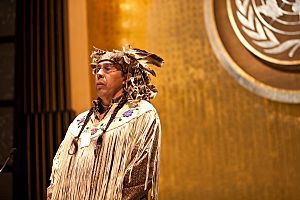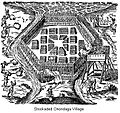Onondaga people facts for kids

Todadaho Sid Hill, Traditional Chief of the Onondaga Nation at the United Nations Permanent Forum on Indigenous Issues
|
|
| Regions with significant populations | |
|---|---|
| Unknown | |
| 856 (2019) | |
| Languages | |
| English, Onondaga, Other Iroquoian languages. | |
| Religion | |
| Longhouse, Handsome Lake, Gai'hwi:io, Kanoh'hon'io, Kahni'kwi'io, Other Indigenous Religion | |
| Related ethnic groups | |
| Seneca Nation, Oneida Nation, Tuscarora Nation, Mohawk Nation, Cayuga Nation, other Iroquoian peoples | |
The Onondaga people (in their own language, Onöñda’gaga’) are also known as the "Hill Place people." They are one of the five original nations that formed the powerful Iroquois (or Haudenosaunee) Confederacy in North America. Their traditional home is in what is now Onondaga County, New York, south of Lake Ontario.
Because they are located in the middle of the Iroquois lands, the Onondaga are called the "Keepers of the Fire." This means they play a very important role in the Confederacy. The Cayuga and Seneca nations live to their west. The Oneida and Mohawk nations live to their east. Historically, the Iroquois government met at the Onondaga village, which was their capital. Even today, the traditional chiefs meet there.
In the United States, many Onondaga people live on the Onondaga Reservation. Other Onondaga people live in Canada, near Brantford, Ontario, on the Six Nations territory. This land used to be hunting grounds for the Haudenosaunee. Many members of the Confederacy moved there after the American Revolution. The British had promised to protect their lands, but a treaty in 1783 gave the territory to the United States.
Contents
History of the Onondaga People
The Onondaga people have a rich history that goes back many centuries. Their stories and archaeological finds help us understand their past.
How the Iroquois Confederacy Began
According to the Onondaga's oral traditions, a wise leader called the Great Peacemaker helped form the Haudenosaunee Confederacy. He visited the Onondaga and other tribes to share his teachings. One important story tells that when the Seneca nation was deciding whether to join the Confederacy, a solar eclipse happened. Scientists believe this eclipse likely occurred in 1142 AD.
Archaeological studies support these old stories. Scientists use a method called carbon dating to find the age of ancient sites. Carbon dating of Onondaga villages shows that people lived there starting around 1200 AD. These villages continued to grow for hundreds of years.
Onondaga During the American Revolution
During the American Revolutionary War, the Onondaga Nation first tried to stay neutral. This meant they didn't pick a side. However, some Onondaga warriors did take part in attacks on American settlements. On April 20, 1779, American forces attacked the main Onondaga village. After this, the Onondaga sided with most of the Iroquois League. They fought against the American colonists, joining forces with the British.
After the United States became independent, many Onondaga people moved to Upper Canada. They followed a leader named Joseph Brant. The British Crown gave them land at Six Nations.
Treaty of Canandaigua
On November 11, 1794, the Onondaga Nation and other Haudenosaunee nations signed the Treaty of Canandaigua with the United States. In this treaty, the United States officially recognized the Onondaga's right to their homeland. This was stated in Article II of the treaty.
Importance of the Onondaga Nation
The Onondaga Nation was very important in forming the Iroquois League. This made them highly respected by other tribes.
- The "Tree of Peace," a symbol of the Confederacy, was planted on Onondaga land.
- Onondaga was seen as the capital of the Iroquois lands.
- The Onondaga were known as the "Central Fire-Keepers" of the Confederacy.
- They were also considered the guardians or watch keepers of the League. Their job was to protect traditions and laws.
- The culture hero Hiawatha was an Onondaga. He was key in organizing the early League.
- The important title of Tadodaho was always held by an Onondaga chief. This chief was the main leader and settled disagreements among the Confederacy's Lords.
- The Onondaga had the most chief titles and the most clans among the Iroquois.
- Handsome Lake, a Seneca leader who created his own Code of teachings, died in Onondaga territory.
Onondaga Customs and Traditions
The Onondaga people have many special customs and ceremonies that show their deep respect for nature and their beliefs.
Ceremonies and Feasts
The Onondaga practice a custom called "sprinkling of ashes" when treating sick people. They also have a public confession of sins using a string of wampum (shell beads). Wampum is used for all important public matters.
Their funerals are usually quiet and serious, with women covering their faces. The Onondaga also celebrate several important feasts throughout the year, based on the seasons:
- Planting Feast: This happens in May, or when the ground is ready for planting. It includes three days of religious services, a children's dance, and special dances for the Four Persons, the Holder for the Heavens, and the Thunder. There is also time for games.
- Strawberry Feast: This feast takes place when strawberries are ripe. It includes dancing for the Thunder and a feast of strawberries.
- Green Bean Dance: This occurs when green beans are ready to be eaten. There are dances for the Thunder, and a mix of war and feather dances.
- Green Corn Dance: This always follows the Green Bean Dance. It involves three days of religious services, a children's day, and dances for the Four Persons, the Holder of the Heavens, and the Thunder, along with a feast.
- Thanksgiving Feast: Held in October, this feast is very similar to the Green Corn Dance.
Giving Thanks
Giving thanks is very important to the Onondaga people. This is shown in all their ceremonies. Ceremonial songs are performed in the longhouse. People dance in a counter-clockwise direction, because this is the direction of Mother Earth, the moon, and the stars, which give life. The more lively the singing and dancing, the more thanks is given to the Creator.
The Onondaga use the lunar calendar to know when their ceremonies should happen. Special people called faith-keepers are in charge of starting these ceremonies based on the different moons.
Onondaga Culture and Daily Life
Before European settlers arrived, several things defined Onondaga life:
- Villages were often built on high, defensible spots away from rivers. They often had earthen walls for protection.
- Pottery and smoking pipes slowly changed in their shapes and decorations over time.
- Stone and bone tools also gradually changed and improved.
- Their ways of getting food stayed mostly the same.
- Their house forms and communal living arrangements continued.
- They often used human face designs in their art.
- There is evidence of bear ceremonies and, in some cases, cannibalism.
Onondaga Government
The Onondaga in New York have a traditional government system. Chiefs are chosen by clan mothers, not elected. The Onondaga follow the Haudenosaunee clan system, which is led by women. Only an Onondaga woman can have Onondaga children. People in the same clan are considered family, even if they are from different nations. When people marry, they must choose a partner from a different clan. Onondaga people believe it is their duty to help and support their clan members during hard times, sickness, and death.
In 2005, the Onondaga Nation filed a lawsuit in federal court. They wanted their ownership of over 3,000 square miles (7,800 km2) of their old lands to be recognized. These lands are centered around Syracuse, New York. They hoped to have more say in cleaning up places like Onondaga Lake, which are polluted. However, the court rejected their claim in 2012, and the Supreme Court did not hear their appeal in 2013.
On June 29, 2022, a positive step happened: 1,023 acres of land were returned to the Onondaga Nation.
Sports and Recreation
The Onondaga people really enjoyed sports and being active. Lacrosse and foot races were always very popular. They also learned many games from European settlers. These included games like mumble the peg, marbles, some ball games, pull away, and fox and geese in the snow. They played hide and seek and blindman's bluff, but they did not play games with songs.
Notable Onondaga People
Many important individuals have come from the Onondaga Nation.
- Leon Shenandoah (1915–1996), a Tadodaho (a main chief)
- Oren Lyons (lives at Onondaga and is a Faithkeeper, but is Seneca)
- Day Starr (1947–2020), Artist and activist, Wolf Clan
- Tom Longboat (Six Nations)
- Canasatego, Hiawatha, Tadodaho of the Iroquois Confederacy
- Tadodaho Sidney Hill
- Samuel George (1795–1873), also known as Hononwirehdonh or 'Great Wolf', a chief from 1850 to 1873
- Madge Skelly (1903–1993), actress, director, speech pathologist
- Lyle Thompson (born 1992), professional lacrosse player
- Gail Tremblay (poet)
- Tonya Gonnella Frichner (1947–2015), lawyer and activist
- Eric Gansworth (poet, novelist, and visual artist)
- Erik J. Sorensen (chemist)
Onondaga Today
Today, Onondaga people live in two main areas:
- The Onondaga Reservation south of Nedrow, New York, near Syracuse.
- The Onondaga of Ohswegen and Bearfoot Onondaga communities, both located at Six Nations of the Grand River, Ontario, Canada.
Other Ways to Spell Onondaga
You might see the name Onondaga spelled in different ways, depending on the language:
- Onöñda'gega' in Onondaga language
- Onontakeka in Oneida language
- Onondagaono in Seneca language
Images for kids
-
Sketch by Samuel de Champlain of his attack on an Onondaga village.
See also
 In Spanish: Onondaga para niños
In Spanish: Onondaga para niños




